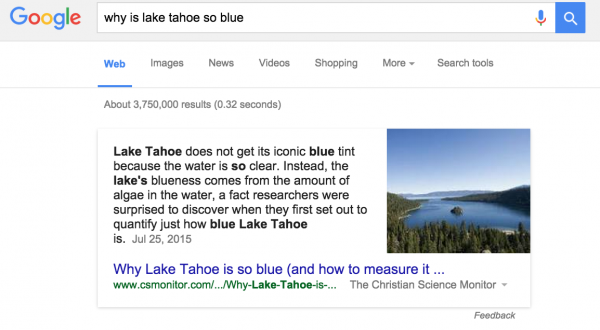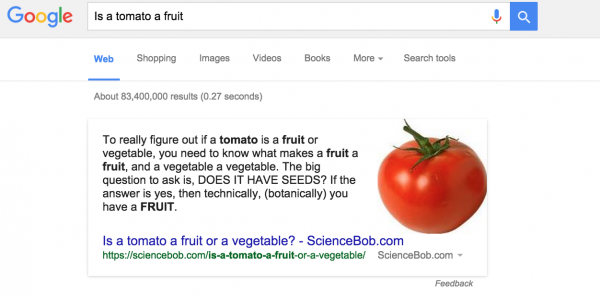Google quick answers are being featured at the top of their search results pages—here’s how to nail that prime spot.
Are you publishing high-quality content? If you’re one of the many established publishers that we work with every day, then the answer is probably “yes.” You’re the stronghold in your niche. You’re the New York Times of your niche. You pay well for your content, it goes through rounds of editing, is fact-checked, grammar-checked, and worthy of a printed page.
When search engines like Google tell you that all you need to do in order to rank well is to write high-quality content, that’s extremely non-helpful for the good eggs who are already publishing, by most standards, very high-quality content.
[text_ad]
And yes, Google can create cars that drive themselves, and so they can basically read the Internet, but they’re not human. So they use other indicators to identify high-quality content that goes beyond basic text like social media shares and inbound links, amongst other things like how your site is built, and other technical factors.
One new piece of real estate in search is the Google Quick Answers result. It looks like this:

To get listed as the featured answer for this question, you will need to consistently be the best answer. That means when people click on your article when they search for a question, they don’t hit the “back” button and increase your bounce rate. Here’s how to write a post that will land you in Google Quick Answers.
First, keywords are necessary
We monitor dozens of publishers’ sites and I can tell you with absolute certainty, that if you’re writing an article about choosing the best cruise line for couples, you’ll be ranked higher and get much more search traffic if you title it something like,”how to pick the best cruise line for couples” and not “Bon Voyage” to be cute.
Save your pithy headlines for print, Tweets and email subject lines. That’s where they’re most effective.
Also, research suggests that Google only excerpts posts for Quick Answers that are titled as a question.
In order to determine how you should title your article, you’d use Google’s Keyword Planner to find phrases related to the article you want to write. You’ll find:
There are 22,200 people per month searching for “best cruise lines“
There are 880 people per month searching for “best cruise lines for couples“
There are 320 people per month searching for “what are the best cruise lines”
But this isn’t a guarantee that you’ll get all 23,400 searches if you title it “what are the best cruise lines for couples”, or that you’ll rank on page one for all the terms above.
There are 253,000 other pages competing for “best cruise lines.”
There are 967,000 other pages competing for “”best cruise lines for couples.“
There are 36,500 other pages competing for “what are the best cruise lines.”
In this case, I’m seeing that writing about cruise lines for couples is pretty darn competitive. But guess what?
There are 210 people per month searching for “best cruise lines for singles”
… and only 1,910 other competing pages.
So I might decide to write a post called “what are the best cruise lines for singles” and take the 22,730 searches instead for a keyword I can get ranked on very easily.
Does this mean you shouldn’t write about cruise lines for couples?
Of course you will. Leaving out the obvious counterpart to an article on cruises for singles would be silly. Keyword research is simply a method of prioritization.
Based on the fact that there’s such little competition for “what are the best cruise lines,” I’d suggest a series on this topic:
What are the best cruise lines for … kids (1,000 searches per month)
What are the best cruise lines for … families (480 searches per month)
What are the best cruise lines for … adults (390 searches per month)
What are the best cruise lines for … teens (260 searches per month)
The Google Quick Answers box in Google listings is a highly prominent field, and worth the effort to try and land it as much as you can through question-based posts.

If your goal is to be featured in this slot, the first step is to title your posts accordingly. If this is all you do, you can show up in this box, and Mequoda already has for several phrases.
According to experts like Kirill Kronrod, a senior global SEO Manager at Adobe, there’s little extra beyond basic SEO that you need to do to be featured.
It’s about half luck, and half being the best search result for the question. Your post should consistently be clicked on in search, and not have a high bounce rate (when someone clicks the back button.) That’s how Google determines if your answer is the right answer for the question being asked.
The post should be cleanly organized, using a list if it’s a how-to post, for example. Nail the technical SEO aspects like using H1 tags for the title, H2 for the subtitle, and H3 for any section headers. Cross link to other helpful articles within your site, and don’t have any janky code wandering around.
Have you landed in Google Quick Answers? How did you get there? Leave a comment and let’s discuss.


